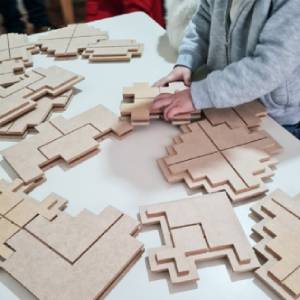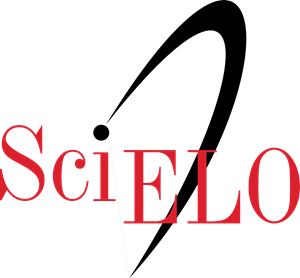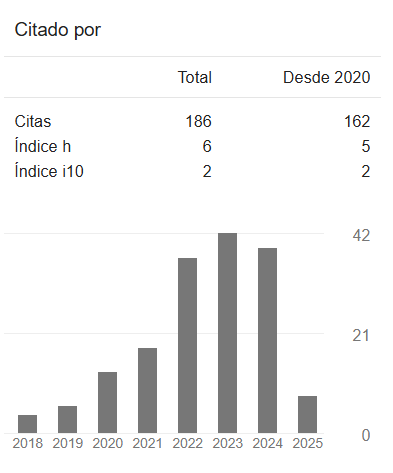Design of educational games
An experience in digital fabrication through a hybrid training proposal in higher education
DOI:
https://doi.org/10.35305/23626097v11i21.474Keywords:
hybrid education, architecture, digital manufacturingAbstract
This study aims to observe teaching practices in the field of designer and architect training through the lens of new scenarios arising from the consolidation of information society and global events. In particular, we focus on the COVID-19 pandemic, which recently and dramatically affected humanity's habits of coexistence. We describe an educational experience of transition between a training modality mediated by a technological interface and a face-to-face instance dealing with a design process for developing a set of didactic games to stimulate the principles of space, movement, and balance for children between 3 and 12 years old. The process follows a sequence of three moments: the first case consists of distance learning in digital fabrication carried out in 2021; the second one introduces the development and face-to-face production at the higher education institution in 2022; and the third one, which was also face-to-face, addresses the validation of the proposal in a kindergarten in 2023. The experience concludes with a proposal for a hybrid training model to develop technological competencies in the elaboration of digital fabrication projects.
Downloads
Metrics
References
Blikstein, Paulo. (2013). Digital Fabrication and ‘Making’ in Education: The The Democratization of Invention. Doi: 10.14361/transcript.9783839423820.203.
Engel y Coll (2022) Entornos híbridos de enseñanza y aprendizaje para promover la personalización del aprendizaje. Revista Iberoamericana de Educación a Distancia, 25(1), doi: https://doi.org/10.5944/ried.25.1.31489
Gershenfeld, N. (2012). How to Make Almost Anything: The Digital Fabrication Revolution. Foreign Affairs, 91(6), 43–57. http://www.jstor.org/stable/41720933
Lion, C. (coord.) (2023). Repensar la educación híbrida después de la pandemia. CABA, Argentina: UNESCO. Disponible en: https://asociacionvenezolanadesociologia.org/wp-content/uploads/2023/06/Repensar-la-educacion-hibrida-despues-de-la-pandemia.pdf
Ministerio de Educación de Chile. (2024). Bases curriculares para la educación parvularia. Recuperado de: https://parvularia.mineduc.cl/wp-content/uploads/2019/09/Bases_Curriculares_Ed_Parvularia_2018-1.pdf
Marmolejo, M., y Vásquez, L. (2021). Modelo didáctico proyectual para entornos virtuales. Cuadernos del Centro de Estudios en Diseño y Comunicación, (135), 87-105, doi: https://doi.org/10.18682/cdc.vi135
Quezada, N. F., y Álvarez, J. C. (2021b). Aprendizaje Basado en Equipos: La perspectiva de los futuros profesores. Revista De Estudios Y Experiencias En Educación, 20(42), 117–135. doi: https://doi.org/10.21703/rexe.20212042ferrada7
Rodríguez, A., Romero, J., y Rodríguez, J. (2024). Formulación de un diseño de instrumentación didáctica en b-Learning para educación superior. Revista Latinoamericana de Estudios educativos, 54(1), 325–372.
Rodríguez, L. G., y Fiscarelli, D. M. (2023). Análisis de las modalidades didácticas en arquitectura: sobre el taller, la formación y el saber proyectual. Estudios del Hábitat/Estudios Del Hábitat, 20(2), e114, doi: https://doi.org/10.24215/24226483e114
Sacavino, S. B., y Candau, V. M. (2022). Enseñanza Híbrida: desafíos y potencialidades. Estudios Pedagógicos, 48(2), 257–266, doi: https://doi.org/10.4067/s0718-07052022000200257
Universidad UNIACC. Misión, visión y valores institucionales, 2024. Disponible en: https://www.uniacc.cl/universidad/mision-vision-y-valores/

Published
How to Cite
Issue
Section
License
Copyright (c) 2024 A&P Continuidad

This work is licensed under a Creative Commons Attribution-NonCommercial-ShareAlike 4.0 International License.
Open access policy
A&P Continuidad is a non-profit and open access publication. According to Mexico Declaration on Cultural Policies, the journal distribution is submitted to Creative Commons Attribution-Noncommercial-ShareAlike 4.0 International Public License (CC BY-NC-SA). “Neither the commercial use of the original work nor that of the possible derivative works are allowed. The distribution of derivative works should be submitted to the license regulating the original work. This license is not free.”
A&P Continuidad authorizes the partial or full reproduction of texts and graphs provided that the source is cited. Authors are exclusively responsible for the criteria expressed in the articles which do not necessarily reflect the opinion of the Editorial Committee or that of the Direction Board. The copyright of the published articles pertains to their authors or publishers.
Transfer of rights
The acceptance of an article to be published implies the author’s transfer of rights to the journal. Authors continue to have the right to use the material in future books or publications, approve or veto the republication of their works as well as the rights related to patents or other rights. Transfer of rights form may be downloaded here.





























 This OJS site and its metadata are under a
This OJS site and its metadata are under a 

